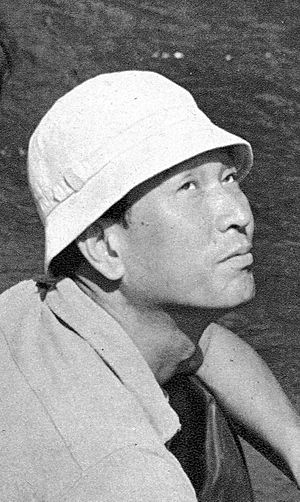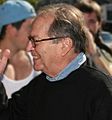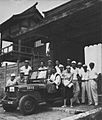Akira Kurosawa facts for kids
Quick facts for kids
Akira Kurosawa
Junior Third Rank
|
|
|---|---|
| 黒澤 明 | |

Kurosawa on the set of Seven Samurai in December 1953
|
|
| Born | March 23, 1910 |
| Died | September 6, 1998 (aged 88) Setagaya, Tokyo, Japan
|
| Resting place | An'yō-in, Kamakura, Kanagawa, Japan |
| Occupation |
|
| Years active | 1936–1993 |
|
Notable work
|
|
| Height | 182 cm (6 ft 0 in) |
| Spouse(s) |
Yōko Yaguchi
(m. 1945; |
| Children | Hisao (b. 1945–) and Kazuko (b. 1954–) |
| Awards |
|
| Japanese name | |
| Kanji | 黒澤 明 |
| Romanization | Kurosawa Akira |
| Signature | |
 |
|
Akira Kurosawa (March 23, 1910 – September 6, 1998) was a Japanese film director and screenwriter, who directed 30 films in a career spanning 57 years. He is regarded as one of the most important and influential filmmakers in the history of cinema.
Biography
Kurosawa was born on March 23, 1910, in Ōimachi in the Ōmori district of Tokyo. His father Isamu (1864–1948), a member of a samurai family from Akita Prefecture, worked as the director of the Army's Physical Education Institute's lower secondary school, while his mother Shima (1870–1952) came from a merchant's family living in Osaka. Akira was the eighth and youngest child of the moderately wealthy family, with two of his siblings already grown up at the time of his birth and one deceased, leaving Kurosawa to grow up with three sisters and a brother.
In addition to promoting physical exercise, Isamu Kurosawa was open to Western traditions and considered theatre and motion pictures to have educational merit. He encouraged his children to watch films; young Akira viewed his first movies at the age of six. An important formative influence was his elementary school teacher Mr. Tachikawa, whose progressive educational practices ignited in his young pupil first a love of drawing and then an interest in education in general. During this time, the boy also studied calligraphy and Kendo swordsmanship.
Kurosawa entered the Japanese film industry in 1936, following a brief stint as a painter. After years of working on numerous films as an assistant director and scriptwriter, he made his debut as a director during World War II with the popular action film Sanshiro Sugata (a.k.a. Judo Saga).
After the war, the critically acclaimed Drunken Angel (1948), in which Kurosawa cast then-unknown actor Toshiro Mifune in a starring role, cemented the director's reputation as one of the most important young filmmakers in Japan. The two men would go on to collaborate on another 15 films.
Rashomon, which premiered in Tokyo, became the surprise winner of the Golden Lion at the 1951 Venice Film Festival. The commercial and critical success of that film opened up Western film markets for the first time to the products of the Japanese film industry, which in turn led to international recognition for other Japanese filmmakers.
Kurosawa directed approximately one film per year throughout the 1950s and early 1960s, including a number of highly regarded (and often adapted) films, such as Ikiru (1952), Seven Samurai (1954) and Yojimbo (1961).
In 1977, American director George Lucas released Star Wars, a wildly successful science fiction film influenced by Kurosawa's The Hidden Fortress, among other works. Lucas, like many other New Hollywood directors, revered Kurosawa and considered him a role model, and was shocked to discover that the Japanese film-maker was unable to secure financing for any new work. The two met in San Francisco in July 1978 to discuss the project Kurosawa considered most financially viable: Kagemusha, the epic story of a thief hired as the double of a medieval Japanese lord of a great clan. Lucas, enthralled by the screenplay and Kurosawa's illustrations, leveraged his influence over 20th Century Fox to coerce the studio that had fired Kurosawa just ten years earlier to produce Kagemusha, then recruited fellow fan Francis Ford Coppola as co-producer.
The film became a massive hit in Japan. The film was also a critical and box office success abroad, winning the coveted Palme d'Or at the 1980 Cannes Film Festival in May.
The international success of Kagemusha allowed Kurosawa to proceed with his next project, Ran, another epic in a similar vein.
Ran won several awards in Japan, but was not quite as honored there as many of the director's best films of the 1950s and 1960s had been. Although Kurosawa was nominated as Best Director at the 58th Academy Awards, the award was won by Sydney Pollack for directing Out of Africa). Ran's costume designer, Emi Wada, won the movie's only Oscar.
Kagemusha and Ran, particularly the latter, are often considered to be among Kurosawa's finest works. After Ran's release, Kurosawa would point to it as his best film, a major change of attitude for the director who, when asked which of his works was his best, had always previously answered "my next one".
In 1990, Kurosawa accepted the Academy Award for Lifetime Achievement.
On September 6, 1998, Kurosawa died of a stroke in Setagaya, Tokyo, at the age of 88.
His career has been honored in many ways through critical studies and biographies in both print and video, and by releases in many consumer media formats.
Legacy and cultural impact
Kurosawa is often cited as one of the greatest filmmakers of all time. In 1999, he was named "Asian of the Century" in the "Arts, Literature, and Culture" category by AsianWeek magazine and CNN, cited as "one of the [five] people who contributed most to the betterment of Asia in the past 100 years". Kurosawa was ranked third in the directors' poll and fifth in the critics' poll in Sight & Sound's 2002 list of the greatest directors of all time. In commemoration of the 100th anniversary of Kurosawa's birth in 2010, a project called AK100 was launched in 2008. The AK100 Project aims to "expose young people who are the representatives of the next generation, and all people everywhere, to the light and spirit of Akira Kurosawa and the wonderful world he created".
Awards and honors
Two film awards have also been named in Kurosawa's honor. The Akira Kurosawa Award for Lifetime Achievement in Film Directing is awarded during the San Francisco International Film Festival, while the Akira Kurosawa Award is given during the Tokyo International Film Festival.
Kurosawa has also been given a number of state honors, including being named as an officer of the French Légion d'honneur in 1984, a Knight Grand Cross of the Order of Merit of the Italian Republic in 1986, and was the first filmmaker to receive the Order of Culture from his native Japan in 1985. Posthumously, he was recognized with the Junior Third Court Rank, which would be the modern equivalent of a noble title under the Kazoku aristocracy.
Images for kids
-
Kurosawa (left) and Mikio Naruse (right) during the production of Avalanche (1937)
-
Toshiro Mifune, a frequent lead in Kurosawa's films, on the poster of 1950's Scandal
-
Sidney Lumet successfully requested that Kurosawa be nominated as Best Director for his film Ran at the 58th Academy Awards. The award was ultimately won by Sydney Pollack.
-
Steven Spielberg helped finance the production of several of Kurosawa's final films. Spielberg at his masterclass at the Cinémathèque Française in 2012.
-
Ingmar Bergman, shown here in a bust located in Kielce, Poland, was an admirer of Kurosawa's work.
-
Jacques Rivette, a prominent critic of the French New Wave who assessed Mizoguchi's work to be more wholly Japanese in comparison to Kurosawa's.
See also
 In Spanish: Akira Kurosawa para niños
In Spanish: Akira Kurosawa para niños











